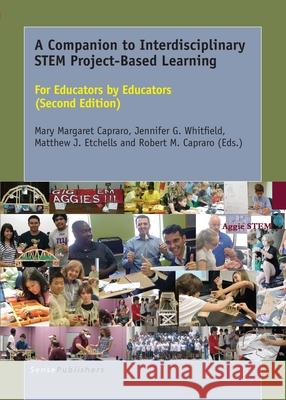A Companion to Interdisciplinary STEM Project-Based Learning » książka
A Companion to Interdisciplinary STEM Project-Based Learning
ISBN-13: 9789463004848 / Angielski / Miękka / 2016 / 222 str.
This text contains 25 Project-Based Learning (PBL) lessons written by a combination of undergraduate preservice teachers, inservice teachers, and graduate students. Everyone who wrote a chapter strives to improve STEM education to help others implement standards-based STEM instruction that takes learning in isolation to greater accountability through integrated and meaningful tasks that answer the question every teacher dreads: When am I going to use this? The PBLs were written to implement in middle and high-school classrooms. All of them are interdisciplinary in nature. We have divided them into six themes: construction and design, water, environment, mixtures, technology, nutrition and genetics. Each lesson contains a "schedule at a glance" and the "well-defined outcome" so you can quickly see how a particular PBL fits into your curriculum. Objectives are listed along with STEM connections written as objectives. We have included all materials needed and then each day of activities including an imbedded engagement, exploration, explanation, evaluation (including rubrics), and extension. We have tried to include everything necessary for successful implementation. This practical book is the perfect companion to the handbook for learning about implementing PBLs: Project-Based Learning: An Integrated Science, Technology, Engineering, and Mathematics (STEM) Approach - second edition
This text contains 25 Project-Based Learning (PBL) lessons written by a combination of undergraduate preservice teachers, inservice teachers, and graduate students. Everyone who wrote a chapter strives to improve STEM education to help others implement standards-based STEM instruction that takes learning in isolation to greater accountability through integrated and meaningful tasks that answer the question every teacher dreads: When am I going to use this? The PBLs were written to implement in middle and high-school classrooms. All of them are interdisciplinary in nature. We have divided them into six themes: construction and design, water, environment, mixtures, technology, nutrition and genetics. Each lesson contains a "schedule at a glance" and the "well-defined outcome" so you can quickly see how a particular PBL fits into your curriculum. Objectives are listed along with STEM connections written as objectives. We have included all materials needed and then each day of activities including an imbedded engagement, exploration, explanation, evaluation (including rubrics), and extension. We have tried to include everything necessary for successful implementation. This practical book is the perfect companion to the handbook for learning about implementing PBLs: Project-Based Learning: An Integrated Science, Technology, Engineering, and Mathematics (STEM) Approach - second edition











